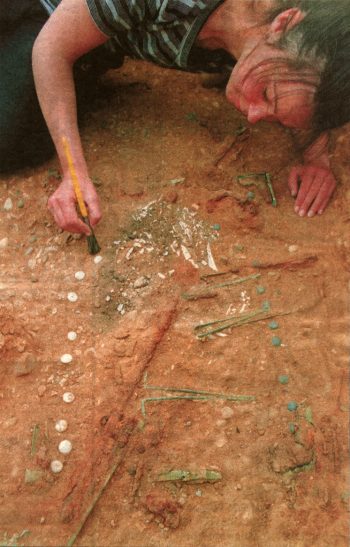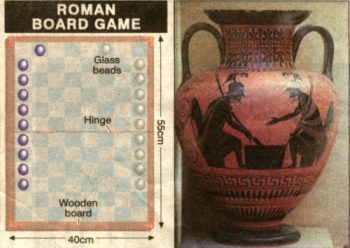

Opening gambit in early version of draughts
Roman board game found at burial site
BY NIGEL HAWKES, SCIENCE EDITOR
|

A MYSTERIOUS board game that kept the Romans amused down the centuries has been found laid out and ready to play in a 2,000-year-old burial site in Essex. The find is remarkable because, although there is plenty of evidence of Roman games using boards and pieces, a complete game with the pieces set out has never before been found. It also gives the strongest clues yet about how to play one of the most popular Roman games, whose rules were never committed to paper. "It is an immensely exciting discovery," said Philip Crummy, of the Colchester Archaeological Trust, who is directing the dig at Stanway, where the ancient British nobility were buried. 'It is the first time that a game like this has been found virtually intact, and with all the pieces in place, just as they would have been in around the year AD 50. What makes it so special is that we have found the outline of the board as well. The original wood has rotted away and crumbled to dust but the edges, which were made of metal, are still there. We know that the Romans mainly played two types of games: one was a form of ludo, with a dice, and the other was like chess or draughts." The Stanway find is thought to be the latter, and maybe a version of Latrunculi, or little soldiers. The game was buried alongside the bones of its owner, apparently to provide entertainment in the afterlife. It consisted of a hinged wooden chequerboard and 20 pieces, about the size of large chocolate drops. Ten were made of blue glass and ten of white. The first move had already been made. Last night Mr Crummy confirmed that another piece had been found, suggesting that there were 24 pieces in all. "What is a wee bit spooky is that all the pieces are set out as if the game were about to start," he said. "They are lined up along each side of the board, with one blue and one white piece advanced." He said that finding the twenty-first piece was "a bit of a blow at first, but it will be good if we find the rest of the pieces. A total of 24 pieces would fit the pattern of other games that have been found previously." The board itself, probably made of maple, has long since disappeared, but metal corners and a hinge in the centre have survived, enabling its size and shape to be worked out. The board was 55cms by 40cms (2l" by l5") and the pieces are lined up along the longer sides. The game is of Roman origin, though the burial site is that of a prominent British aristocrat of the period just before the Roman conquest under Claudius in AD 43. Romans had already been in Britain for almost a century, so it is no surprise to find native Britons playing Roman games. Dr Irving Finkel, of the British Museum, says that, from descriptions of what Mr Crummy has found, he believes the game to be a version of Latrunculi, a game of strategy played on boards of various sizes. "We have found boards scratched on rocks and drawn on vases," he said. "The Romans never wrote down the rules. They didn't need to; everybody knew them. "The important thing with this find is that the board and the men have turned up together. I don't think there is another example like that anywhere in the world. It's a very important find." 
He said that the object of Latrunculi appeared to have been to trap one of your opponent's pieces between two of yours, thus taking it. The player left with the final piece was the winner. It was undoubtedly a game of strategy, though much simpler than chess. There was some evidence that part of the board was regarded as a citadel to be taken by the opponent. "Games travel with soldiers," Dr Finkel said. "They leap across borders. I suspect there were many local versions of this game, but how it was played we just don't know." Only a fluke enabled the game to survive with its pieces barely moved from their original position, Mr Crummy said. It had been set up in a shallow box before being buried with the bones and personal possessions of a wealthy and prominent person. "First we uncovered the whole row of the blue pieces," Mr Crummy said. "We said "Wouldn't it be great if the white pieces were there as well?' and then, like magic, they appeared." The site is a quarry owned by Tarmac, which has supported the excavation. Ian Findlater, regional director of Tarmac Quarry Products, said: "We had hoped that the excavations would be successful, but we are amazed at what Philip Crummy and his team have discovered." |
|
Ancient Egyptians and the Moors may have played too BY NIGEL HAWKES |
|
HOW did the ancient Britons play the game? Ray Keene, chess correspondent of The Times, believes that he knows. From descriptions of the positions in which the pieces were found, he believes that it is a version of an ancient game called Alquerque. once played by the ancient Egyptians and described in a Moorish manuscript of the 13th century. "This game was the parent of draughts," he said. The Arab name for it was Qirkat, which some people think was the origin of the word chequers. Alquerque is a game of strategy and tactics in which both players have an equal number of pieces at the start. Typically this is 12 on either side. 'The pieces are laid out side by side, on the lines rather than the squares," Keene said. "There would also have been diagonal lines, and the pieces can be moved either diagonally or in a straight line. They capture other pieces by leaping over them. It is clearly the ancestor of draughts." The game is still played in Madagascar, under the name Fanorona. Keene said that the description was closer to this than to Latrunculi, in which he said there were different numbers of pieces on each side, and not all were of equal weight. "The point is that in Alquerque both players start in a position of absolute equality, which is what we see here. I am pretty sure that is what they have found." |